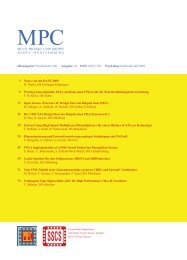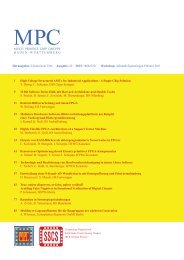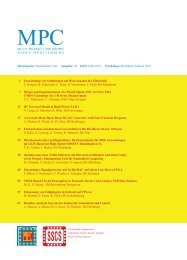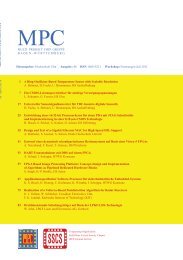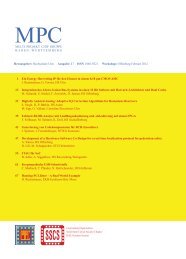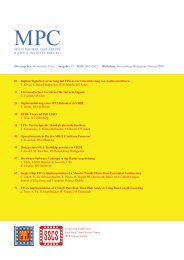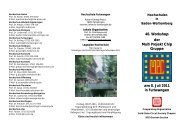[Geben Sie hier die Überschrift ein] - MPC
[Geben Sie hier die Überschrift ein] - MPC
[Geben Sie hier die Überschrift ein] - MPC
- TAGS
- mpc.belwue.de
Sie wollen auch ein ePaper? Erhöhen Sie die Reichweite Ihrer Titel.
YUMPU macht aus Druck-PDFs automatisch weboptimierte ePaper, die Google liebt.
Figure 5: Average distribution of time per phase in percentage of<br />
700 measurements.<br />
ures the data must be analyzed further in terms of<br />
GSM modules, providers and locations.<br />
B. Time and Energy for different GSM modules and<br />
providers<br />
For the analysis and comparison of the energy consumption<br />
depending on different modules two different<br />
modules MOD_A and MOD_B of different manufacturers<br />
were used. Both were tested with the same<br />
external antenna. Additionally, tests with different<br />
providers (T-Mobile and Vodafone) in their home<br />
networks and in international networks using roaming<br />
were performed.<br />
These tests are based on 657 measurements at three<br />
different locations and they are shown in fig. 7 and<br />
fig. 8. Each measurement is represented as bar in the<br />
diagram. The measurements are grouped by module<br />
and provider.<br />
Fig. 7 shows the timing diagram. A critical situation<br />
can be observed in the phase “06 data transmission”.<br />
The combination of module A with the provider<br />
T-Mobile shows a significant variance in the time<br />
used. Certain test runs use even more than 40 s for the<br />
data transmission. However, the same module with a<br />
different provider shows a much lower data transmission<br />
rate.<br />
Energy measurements shown in fig. 8 are based on<br />
the energy consumption of the GSM module. It is<br />
calculated as work in mWh per phase. It is based on<br />
44<br />
MEASUREMENT UNIT FOR ENERGY<br />
EFFICIENT M2M MOBILE COMMUNICATION<br />
Figure 6: Average distribution of energy consumption per phase<br />
in percentage of 700 measurements.<br />
the same data as used in the previous chapter but the<br />
data on the y-axis is the work consumed by the GSM<br />
module.<br />
This illustration shows clearly that a main portion of<br />
the energy consumption lies in the data communication.<br />
In addition, the attachment process still consumes<br />
a significant amount of energy. It is slightly higher for<br />
module B compared to module A. In the main parts<br />
the energy consumption reflects the time requirements.<br />
In [5] different optimization approaches based<br />
on this data are shown.<br />
VII. CONCLUSION<br />
General challenges with high dynamic range current<br />
measurements on GSM/GPRS modules are discussed<br />
and analyzed. By implementing two current measurements,<br />
one for the precise resolution in the lower current<br />
range and one for the higher current range with<br />
less precision, these challenges are overcome.<br />
Instead of having a sampling rate in the range of<br />
MS/s, approximately 3 kS/s are sufficient for interpolating<br />
the actual energy consumption. With this technique<br />
it is possible to show the energy consumed by<br />
the modules in each communication phase. Measurements<br />
with the DC Power Analyzer described in chapter<br />
IV.A show that the inaccuracies of the minor time<br />
resolution and the higher range are still in a reasonable<br />
dimension.


![[Geben Sie hier die Überschrift ein] - MPC](https://img.yumpu.com/8654082/47/500x640/geben-sie-hier-die-uberschrift-ein-mpc.jpg)
